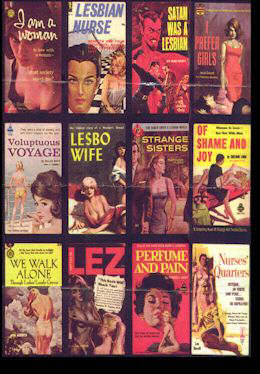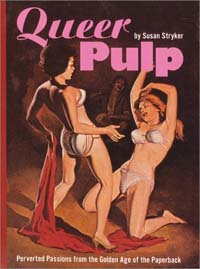 |
|
Queer Pulp: Perverted Passions from the Golden Age of the Paperback by Susan Striker; Chronicle Books; 128 pages; $19.99.
Given my own interest in the genre, I looked forward to reading Queer Pulp: Perverted Passions from the Golden Age of the Paperback. Happily, the book lived up to my expectations. Susan Stryker, Executive Director of the Gay, Lesbian, Bisexual and Transgender Historical Society in San Francisco, obviously had a good time working on Queer Pulp. Stryker was not content with giving us a detailed and informative history of queer pulps - which she does very well, thank you. For inside the dust jacket - easily reversed to showcase a male or female cover - you will find a book that's lavishly illustrated with some of the tackiest, campiest, sexiest cover shots ever seen. Though words cannot describe those covers, perhaps a few titles will give you an indication: Lavender Love Rumble, Hangout for Queers, AC-DC Lover, A Madam's Memoir, I Changed My Sex. The proliferation of pocket-sized paperbacks after World War II led to the publication of books about topics that major publishers usually shunned, such as alternative lifestyles. The period between 1945 and 1965 was a "golden age" for paperback pulps, as publishers tried to outdo each other and attract customers by giving their books the most outlandish covers they could think of. Books ranged from classic to awful, and their authors ranged from respected authors writing under pseudonyms to hacks who were paid by the word. By the same token, publishers ranged from major houses to fly-by-night rackets that often ran afoul of the law. Two infamous pulp racketeers were Sanford Aday and Wallace de Ortega Maxey, who for years put out literary trash out of Fresno, California before they were convicted for obscenity in 1963.
Unlike their lesbian counterparts, gay male pulps did not come into their own until the late sixties and early seventies. (This was the period that I referred to as "The Golden Age of the Gay Paperback.) "Paperbacks exploring gay male themes have a different history than lesbian paperbacks, a history shaped much more directly by legal definitions of obscenity and by the differing values placed on male and female deviance from societal norms," writes Stryker. "Gay paperbacks of that era tended to be graphically sexual, focusing on erotic content at the expense of plot and characterization, and catering to an almost exclusively gay male audience. ... Not until legal standards of obscenity changed in the mid-1960s - the very changes that reshaped the paperback phenomenon itself and brought an end to its golden age - did gay paperbacks truly begin to flourish."
 While lesbian pulps had many "straight" readers - mainly het men who found lesbianism titillating - gay pulps were read by gay men. They were also pornographic, and mostly available at adult bookstores or from adult mail order houses. And because they were sold as pornography, most of the gay pulps' covers featured suggestive blurbs and nude or semi-nude men.
While lesbian pulps had many "straight" readers - mainly het men who found lesbianism titillating - gay pulps were read by gay men. They were also pornographic, and mostly available at adult bookstores or from adult mail order houses. And because they were sold as pornography, most of the gay pulps' covers featured suggestive blurbs and nude or semi-nude men.
Among the gay pulps whose covers grace the pages of Queer Pulp are titles by Richard Amory (Song of the Loon), Phil Andros (When In Rome Do), Chris Davidson (Go Down Aaron), Michael Scott (The Killer Queens) and Carl Corley (Jesse: Man of the Streets - my personal favorite). Though Stryker does a good job relating the history of the queer pulps - and their covers! - Queer Pulp does not discuss the books' liberating effect on a generation of gay and lesbian youth. While the pulps' literary quality leave much to be desired, they gave their readers a positive view of lesbian and gay life and sex that most other books left out. When I was a confused teenager, gay pulps informed me that gay is good, which is why I continue to treasure them long after I've turned to more literary works. To this day good pulp writers like Ann Bannon, Paula Christian, Richard Amory and Phil Andros continue to entertain and enlighten readers of all sexual and gender orientations.
|


 A few years ago, I gave a lecture on The Golden Age of the Gay Paperback: 1966-1975. I have long been a fan of vintage gay paperbacks, which often combined a refreshingly positive view of gay life with outrageous cover art. I have since accumulated a nice collection of pulps - mostly gay but with a few lesbian titles - though they are nothing compared to what you will find at the Stonewall Library and Archives in Fort Lauderdale (shameless plug).
A few years ago, I gave a lecture on The Golden Age of the Gay Paperback: 1966-1975. I have long been a fan of vintage gay paperbacks, which often combined a refreshingly positive view of gay life with outrageous cover art. I have since accumulated a nice collection of pulps - mostly gay but with a few lesbian titles - though they are nothing compared to what you will find at the Stonewall Library and Archives in Fort Lauderdale (shameless plug).
 Jesse Monteagudo is a freelance writer who lives in South Florida with
his domestic partner. He can be reached at
Jesse Monteagudo is a freelance writer who lives in South Florida with
his domestic partner. He can be reached at